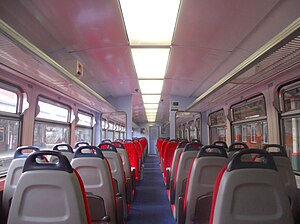| British Rail Class 153 Super Sprinter | |
|---|---|
 KeolisAmey Wales Class 153 at Ty Glas in 2019 | |
 Interior of a refurbished East Midlands Trains unit | |
| In service | 1991–present |
| Manufacturer |
|
| Order no. | 31026[1] |
| Family name | Sprinter |
| Replaced | BR First-Generation DMUs |
| Constructed |
|
| Entered service | 1991 |
| Number built | 70 |
| Number in service | 33 |
| Number preserved | 1 |
| Number scrapped | 12 |
| Formation | Single vehicle: DMSL[1] |
| Diagram | |
| Fleet numbers |
|
| Capacity |
|
| Operators |
|
| Depots |
|
| Specifications | |
| Car body construction | Steel[2] |
| Car length | 23.208 m (76 ft 1.7 in)[2] |
| Width | 2.700 m (8 ft 10.3 in)[2] |
| Height | 3.746 m (12 ft 3.5 in)[2] |
| Doors | Single-leaf sliding plug (2 per side)[5] |
| Wheelbase |
|
| Maximum speed | 75 mph (120 km/h) |
| Weight | 41.2 tonnes (40.5 long tons; 45.4 short tons)[3] |
| Axle load | Route Availability 1 |
| Prime mover(s) | 1 × Cummins NT855-R5 |
| Engine type | Inline-6 4-stroke turbo-diesel[6] |
| Displacement | 14 L (855 cu in)[6] |
| Power output | 213 kW (285 hp)[5] |
| Transmission | Voith T 211 r (hydrokinetic) |
| HVAC | Warm air & hot-water radiators |
| UIC classification | 2′B′ |
| Bogies |
|
| Minimum turning radius | 90 m (295 ft 3 in) |
| Braking system(s) | Electro-pneumatic (tread)[2][5] |
| Safety system(s) | |
| Coupling system | BSI |
| Multiple working | Within class, plus Classes 14x, 15x, and 170[5] |
| Track gauge | 1,435 mm (4 ft 8+1⁄2 in) standard gauge |
| Notes/references | |
| Converted from 35 × Class 155 units[7][8][9] | |
The British Rail Class 153 Super Sprinter are single-coach diesel-hydraulic railcars which were converted from two-coach Class 155 diesel multiple units in the early 1990s. The class was intended for service on rural branch lines, either where passenger numbers do not justify longer trains or to boost the capacity on services with high passenger volume.
- ^ a b c d e Fox & Hughes 1994, pp. 31–32
- ^ a b c d e f g Vehicle Diagram Book No. 220 for Diesel Multiple Unit Trains (Railcars) (PDF). Derby: British Railways Board. 1982. DP248, DP249. Archived (PDF) from the original on 21 January 2015. Retrieved 7 August 2022 – via Barrowmore MRG.
- ^ a b Marsden 2011, p. 115
- ^ Clinnick, Richard (February 2023). "A grand plan for Scotland's railways". Rail Express. No. 321. Horncastle: Mortons Media Group. p. 76. ISSN 1362-234X.
- ^ a b c d Class 153 Diesel Multiple Unit (PDF) (1A ed.). Derby: Porterbrook Leasing Company. January 2014. pp. 17–18. Archived from the original (PDF) on 23 November 2015. Retrieved 9 December 2022.
- ^ a b Marine Engine General Data Sheet N/NT/NTA 855-M (PDF). Columbus, Indiana: Cummins Engine Company. 18 February 2002. p. 1. DS-4962. Archived (PDF) from the original on 7 December 2022. Retrieved 7 December 2022.
- ^ "Our Fleets - Regional Passenger Trains - Class 153". London: Angel Trains. Archived from the original on 25 January 2018. Retrieved 24 January 2018.
- ^ Barclay, Kenny (November 2017). British Rail in the 1980s and 1990s: Diesel Locomotives and DMUs. Stroud: Amberley Publishing. ISBN 978-1-4456-7005-8.
- ^ Thomson, Gordon (July 2016). Railways of Ayrshire. Marlborough: Crowood Press. ISBN 978-1-7850-0148-2.